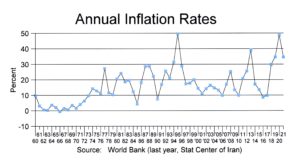May 20, 2022

That is not only one of the worst inflation rates in Iranian history, it is one of the worst inflation rates in the world today.
Furthermore, in the subcategories of the inflation calculation, the food and beverages section recorded inflation at 52 percent and food and beverages make up more than a quarter of what the average Iranian family spends its money on. This makes the ravages of inflation starkly apparent to Iran’s housewives.
The Statistical Center said Iran’s inflation rate, based on comparing it with the rate as of the same month in the previous year was 34.7 percent as of the last month of 1400. By a different measure the average of the previous 12 months the inflation rate for the Persian year was higher at 40.8 percent, but the first rate is the one watched most closely by economists.
In only four previous years since the revolution has the inflation rate been higher than this just-ended year in 2020 (48.7 percent), 2019 (34.8 percent), 2015 (39.3 percent) and 1995 (49.7 percent). In other words, three of the five worst years for inflation since the revolution have been the last three years. Put another way, an average article that cost 100 rials three years ago costs 270 rials today.
Inflation since the revolution has routinely been high. While other countries periodically have spasms of inflation over 10 percent, Iran routinely sees inflation above 10 percent because of its propensity to print money to pay its bills. In fact, in the four decades since the revolution, inflation has been below 10 percent in only three years 1985 when it was 4.9 percent; 1990 when it was 7.6 percent and 2016 when it was 8.7 percent.
As for food and beverages, the Statistical Center follows the retail prices for 53 different products. Last year, the greatest price rise was 181 percent for potatoes, followed by 136 percent for tomatoes and 113 percent for top-grade Iranian rice prompting many families to replace rice with pasta noodles, whose price is now soaring owing to the wheat shortage.
Four food items saw prices decline last year bananas down 27 percent, hydrogenated vegetable oil down 12 percent, carrots down 6 percent and cucumbers down 1 percent. But it’s rather hard to live off bananas, carrots and cucumbers.
As for other countries, the World Bank and International Monetary Fund each track inflation rates in about 200 economies. While they don’t have the same numbers, the World Bank currently reports only six countries with inflation higher than Iran and the IMF only five with higher rates.